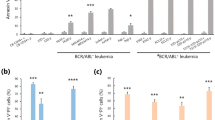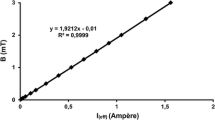Abstract
The bioactive components of dietary phytochemicals are in the spotlight of research institutes, due to their significant antioxidant activities and health-promoting properties. Resveratrol is a polyphenol which is found abundantly in grapes and berries and has long been known as a chemo-preventive agent. The main purpose of this study was to provide a new mechanistic insight into the growth inhibition of acute lymphoblastic leukemia cells by resveratrol along with a DNA damage agent. It was found that the treatment of pre-B ALL cells by resveratrol in the presence or absence of doxorubicin resulted in decreased cell viability and a synergistic increase in cytotoxicity. Cell death was accompanied by a significant increase in phosphorylated p53 at serine 15 and accumulation of PTEN. In addition, resveratrol inhibited the over-expression of p-AKT and p-ERK1/2. These findings clearly demonstrated that resveratrol and doxorubicin synergistically increase the cytotoxicity of pre-B ALL cells via the hyper-activation of two important tumor suppressor proteins and two major signal transduction pathways.





Similar content being viewed by others
References
Athar M et al (2009) Multiple molecular targets of resveratrol: anti-carcinogenic mechanisms. Arch Biochem Biophys 486(2):95–102
Szliszka E, Krol W (2011) The role of dietary polyphenols in tumor necrosis factor-related apoptosis inducing ligand (TRAIL)-induced apoptosis for cancer chemoprevention. Eur J Cancer Prev 20(1):63–69
Mikstacka R, Rimando AM, Ignatowicz E (2010) Antioxidant effect of trans-resveratrol, pterostilbene, quercetin and their combinations in human erythrocytes in vitro. Plant Foods Hum Nutr 65(1):57–63
Lagouge M et al (2006) Resveratrol improves mitochondrial function and protects against metabolic disease by activating SIRT1 and PGC-1α. Cell 127(6):1109–1122
Markus MA, Morris BJ (2008) Resveratrol in prevention and treatment of common clinical conditions of aging. Clin Interv Aging 3(2):331
Szkudelska K, Nogowski L, Szkudelski T (2009) Resveratrol, a naturally occurring diphenolic compound, affects lipogenesis, lipolysis and the antilipolytic action of insulin in isolated rat adipocytes. J Steroid Biochem Mol Biol 113(1):17–24
Um J-H et al (2010) AMP-activated protein kinase-deficient mice are resistant to the metabolic effects of resveratrol. Diabetes 59(3):554–563
Gonzales AM, Orlando RA (2008) Curcumin and resveratrol inhibit nuclear factor-kappaB-mediated cytokine expression in adipocytes. Nutr Metab (Lond) 5(1):17
Pearson KJ et al (2008) Resveratrol delays age-related deterioration and mimics transcriptional aspects of dietary restriction without extending life span. Cell Metab 8(2):157–168
Sánchez-Fidalgo S et al (2010) Dietary supplementation of resveratrol attenuates chronic colonic inflammation in mice. Eur J Pharmacol 633(1):78–84
Sharma S et al (2007) Resveratrol and curcumin suppress immune response through CD28/CTLA-4 and CD80 co-stimulatory pathway. Clin Exp Immunol 147(1):155–163
Csiszar A et al (2009) Resveratrol induces mitochondrial biogenesis in endothelial cells. Am J Physiol Heart Circ Physiol 297(1):H13–H20
Kaur G et al (2007) Effect of wine phenolics on cytokine-induced C-reactive protein expression. J Thromb Haemost 5(6):1309–1317
Athar M et al (2007) Resveratrol: a review of preclinical studies for human cancer prevention. Toxicol Appl Pharmacol 224(3):274–283
Benitez DA et al (2009) Regulation of cell survival by resveratrol involves inhibition of NFκB-regulated gene expression in prostate cancer cells. Prostate 69(10):1045–1054
Filomeni G et al (2007) trans-Resveratrol induces apoptosis in human breast cancer cells MCF-7 by the activation of MAP kinases pathways. Genes Nutri 2(3):295–305
Hu Y et al (2007) Antimyeloma effects of resveratrol through inhibition of angiogenesis. Chin Med J Beijing Engl Ed 120(19):1672
Nonn L, Duong D, Peehl DM (2007) Chemopreventive anti-inflammatory activities of curcumin and other phytochemicals mediated by MAP kinase phosphatase-5 in prostate cells. Carcinogenesis 28(6):1188–1196
Zykova TA et al (2008) Resveratrol directly targets COX-2 to inhibit carcinogenesis. Mol Carcinog 47(10):797–805
Dahia PL et al (1999) PTEN is inversely correlated with the cell survival factor Akt/PKB and is inactivated via multiple mechanisms in haematological malignancies. Hum Mol Genet 8(2):185–193
Gutierrez A et al (2009) High frequency of PTEN, PI3 K, and AKT abnormalities in T-cell acute lymphoblastic leukemia. Blood 114(3):647–650
Montiel-Duarte C et al (2008) Resistance to imatinib mesylate-induced apoptosis in acute lymphoblastic leukemia is associated with PTEN down-regulation due to promoter hypermethylation. Leuk Res 32(5):709–716
Tang D et al (2002) ERK activation mediates cell cycle arrest and apoptosis after DNA damage independently of p53. J Biol Chem 277(15):12710–12717
Scudiero DA et al (1988) Evaluation of a soluble tetrazolium/formazan assay for cell growth and drug sensitivity in culture using human and other tumor cell lines. Cancer Res 48(17):4827–4833
Gottlieb TM et al (2002) Cross-talk between Akt, p53 and Mdm2: possible implications for the regulation of apoptosis. Oncogene 21(8):1299–1303
Alessi DR et al (1996) Mechanism of activation of protein kinase B by insulin and IGF-1. EMBO J 15(23):6541
Manach C et al (2004) Polyphenols: food sources and bioavailability. Am J Clin Nutr 79(5):727–747
Queen BL, Tollefsbol TO (2010) Polyphenols and aging. Curr Aging Sci 3(1):34
Veres B (2012) Anti-inflammatory role of natural polyphenols and their degradation products. In Fernandez R, ed. Severe sepsis and septic shock—understanding a serious killer. Intechopen, p379–410
Yang CS et al (2000) Tea and tea polyphenols in cancer prevention. J Nutr 130(2):472S–478S
Ryan KM, Phillips AC, Vousden KH (2001) Regulation and function of the p53 tumor suppressor protein. Curr Opin Cell Biol 13(3):332–337
Khanna KK et al (1998) ATM associates with and phosphorylates p53: mapping the region of interaction. Nat Genet 20(4):398–400
Kohno M, Pouyssegur J (2006) Targeting the ERK signaling pathway in cancer therapy. Ann Med 38(3):200–211
Ahmad N, Mukhtar H (1999) Green tea polyphenols and cancer: biologic mechanisms and practical implications. Nutr Rev 57(3):78–83
Khalil A et al (2011) ATM-dependent ERK signaling via AKT in response to DNA double-strand breaks. Cell Cycle 10(3):481–491
Mayo LD et al (2002) PTEN protects p53 from Mdm2 and sensitizes cancer cells to chemotherapy. J Biol Chem 277(7):5484–5489
Chen Z et al (2005) Crucial role of p53-dependent cellular senescence in suppression of PTEN-deficient tumorigenesis. Nature 436(7051):725–730
Freeman DJ et al (2003) PTEN tumor suppressor regulates p53 protein levels and activity through phosphatase-dependent and -independent mechanisms. Cancer Cell 3(2):117–130
Acknowledgments
The present authors would like to express their gratitude to Avicenna Research Institute and Tehran University of Medical Sciences for supporting this study. The authors declare no conflict of interest.
Author information
Authors and Affiliations
Corresponding author
Additional information
A. Ghorbani and H. Zand equally contributed to this work.
Rights and permissions
About this article
Cite this article
Ghorbani, A., Zand, H., Jeddi-Tehrani, M. et al. PTEN over-expression by resveratrol in acute lymphoblastic leukemia cells along with suppression of AKT/PKB and ERK1/2 in genotoxic stress. J Nat Med 69, 507–512 (2015). https://doi.org/10.1007/s11418-015-0915-7
Received:
Accepted:
Published:
Issue Date:
DOI: https://doi.org/10.1007/s11418-015-0915-7




